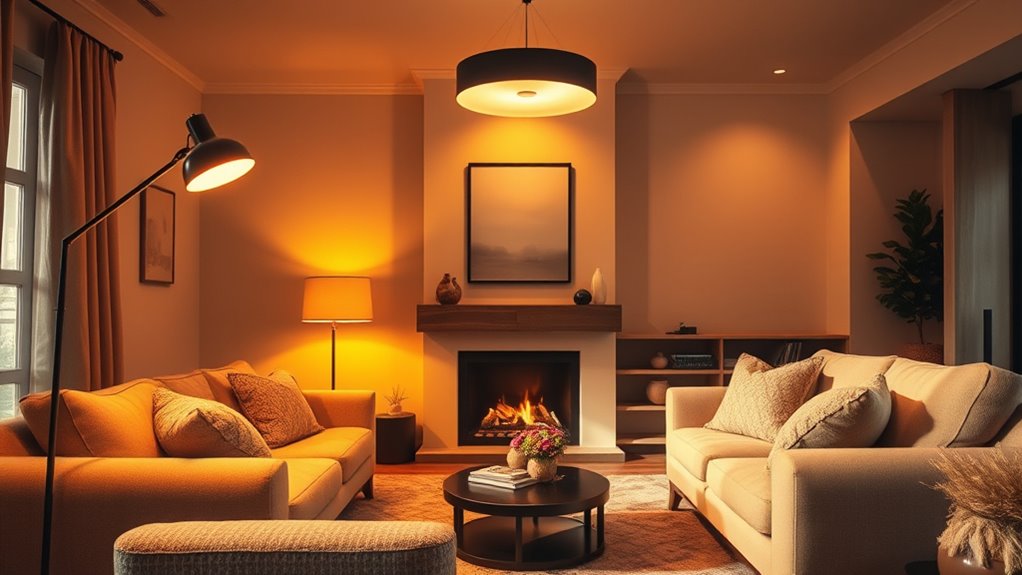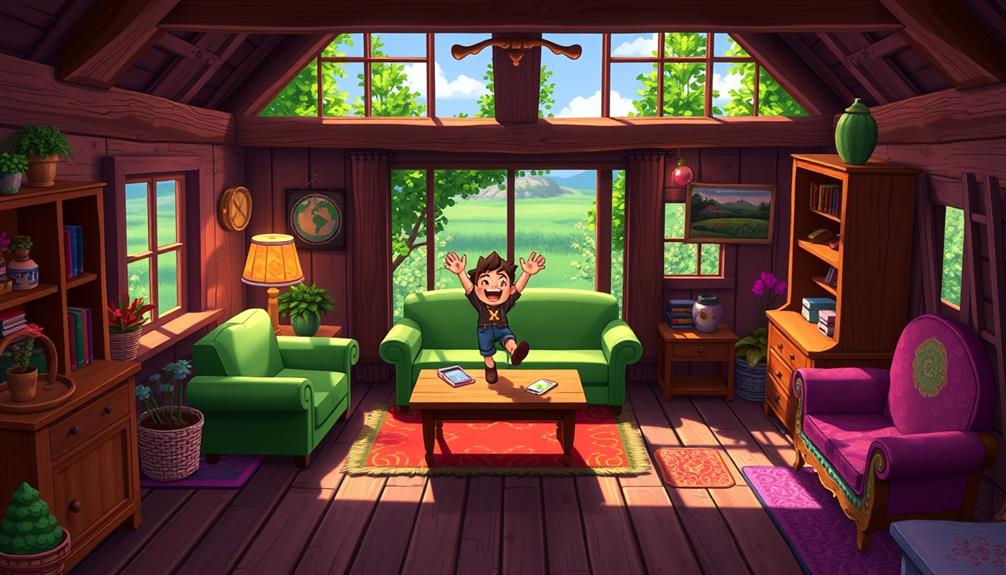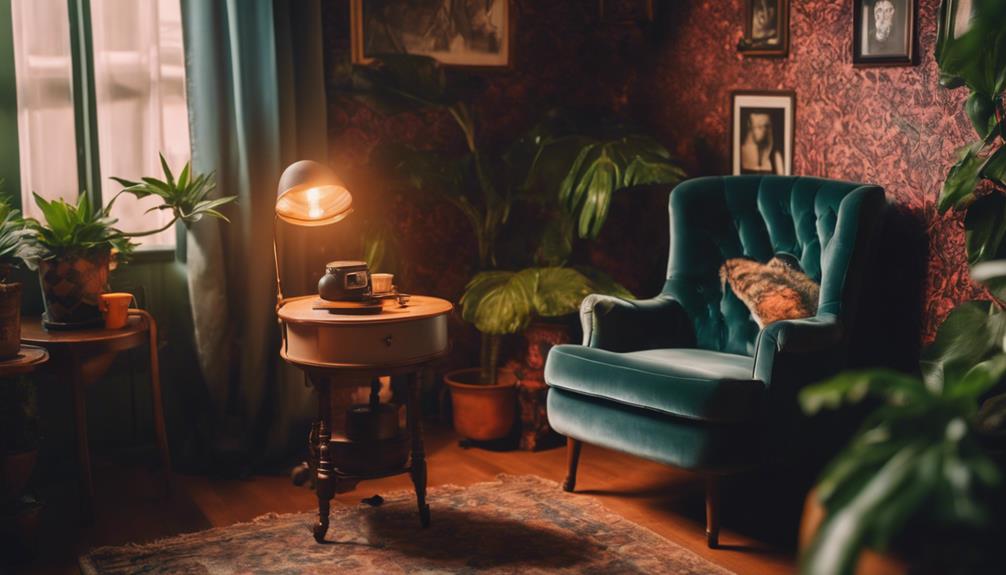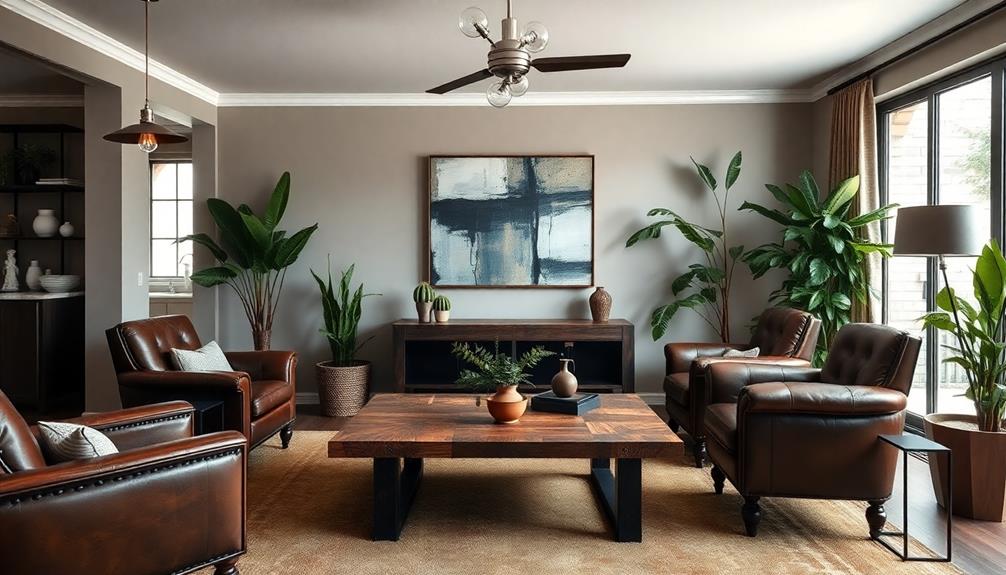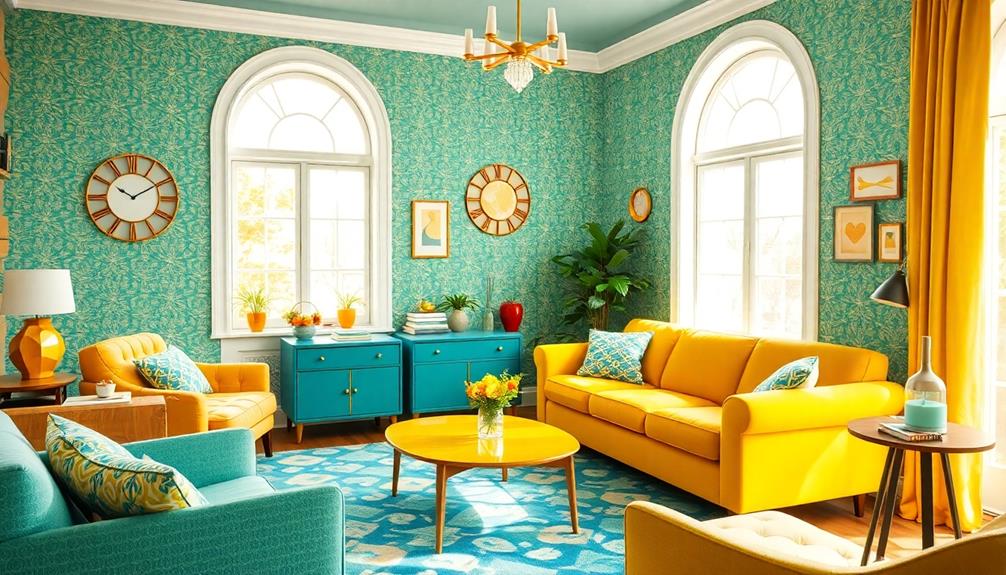To transform your space with lighting, focus on mixing ambient, task, and accent lights to create a layered effect that adds depth and functionality. Choose the right fixtures and bulbs—warm or cool—based on the mood you want to set. Proper placement at eye level or above highlights features and improves flow. Dimming controls let you adjust the atmosphere easily. Keep safety and energy efficiency in mind to make certain a beautiful, safe environment that works for you. Want to learn more?
Key Takeaways
- Incorporate ambient, task, and accent lighting layers for a balanced and versatile space.
- Choose appropriate bulbs and fixtures based on function, style, and safety standards.
- Position lights at eye level and use strategic placement to highlight features and create depth.
- Use dimmers and color temperature controls to adjust mood and ambiance.
- Prioritize energy-efficient options like LEDs and follow safety guidelines for a secure, sustainable setup.
Understanding Different Types of Lighting
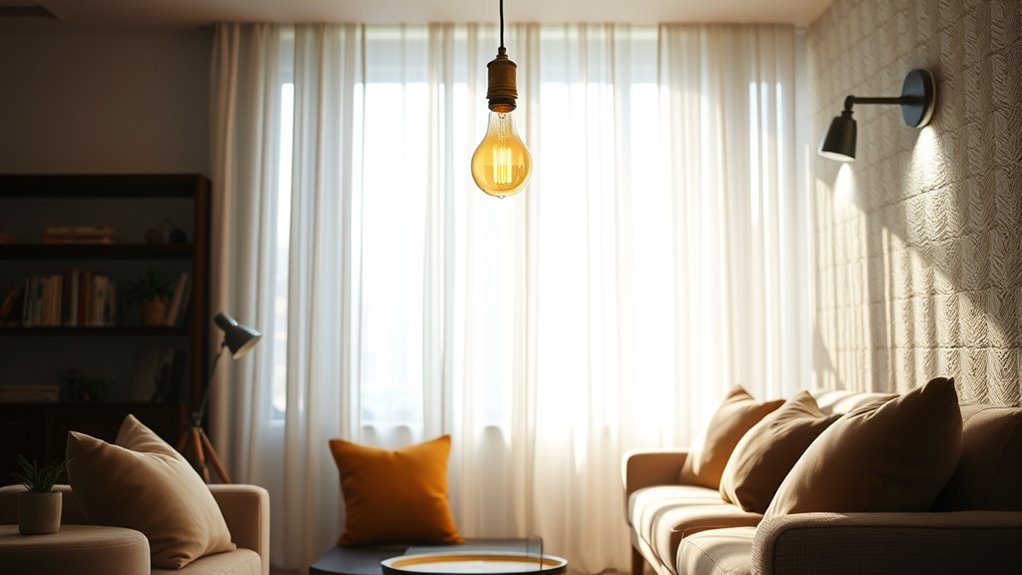
Lighting plays a crucial role in setting the mood and functionality of a space, and understanding the different types available helps you make better choices. There are three main categories: ambient, task, and accent lighting. Ambient lighting provides overall illumination, creating a comfortable background glow. You might use ceiling fixtures or wall-mounted lights for this purpose, and incorporating vertical storage solutions can help you optimize the space around your lighting fixtures. Task lighting focuses on specific areas where you need more brightness, like reading nooks or kitchen counters, often achieved with pendant lights or under-cabinet LEDs. Accent lighting highlights particular features or artwork, adding depth and visual interest; think of spotlights or picture lights. Recognizing these types allows you to design a balanced lighting scheme tailored to your space’s needs and mood. Additionally, incorporating self watering plant pots can help maintain healthy plants indoors with minimal effort, enhancing your space’s ambiance. Understanding lighting design principles can further improve how you utilize different light sources to create a cohesive and inviting environment. Proper application of interior lighting techniques ensures your space feels both functional and aesthetically pleasing.
The Role of Layered Lighting in Your Space
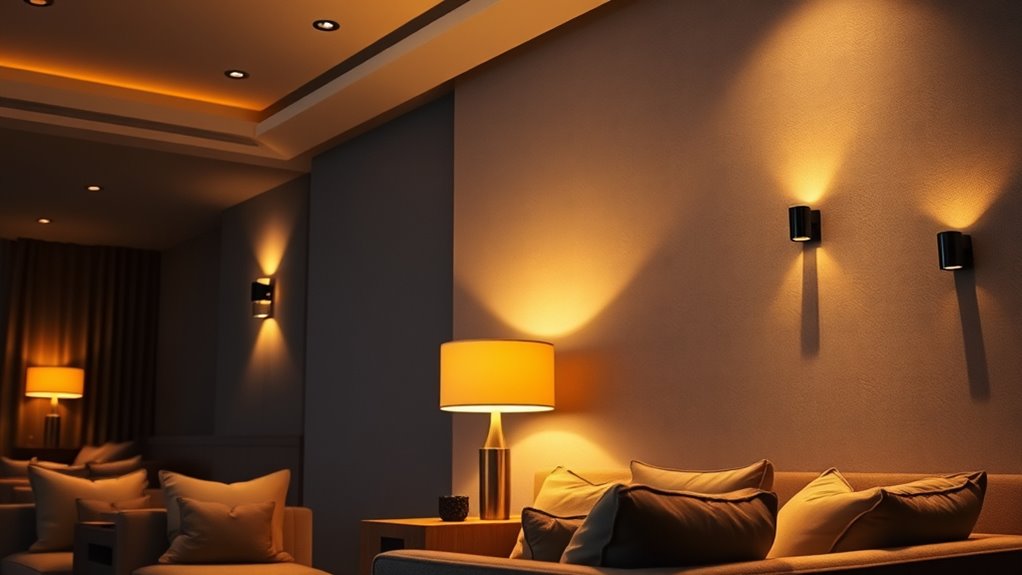
Combining different types of lighting creates a layered effect that enhances both the functionality and ambiance of your space. Layered lighting balances task, ambient, and accent lighting to create a well-rounded environment. It guarantees you have enough light for daily activities while setting the mood. To achieve effective layering, consider these points:
- Use ambient lighting as the foundation to light the entire room evenly.
- Add task lighting where specific activities occur, like reading or cooking.
- Incorporate accent lighting to highlight features or create visual interest.
- Regularly evaluate your lighting setup to ensure it remains energy-efficient and meets your evolving needs.
This approach not only improves practicality but also adds depth and warmth to your space. By thoughtfully combining these layers, you transform a simple room into a versatile, inviting environment that caters to different needs and moods.
Choosing the Right Bulbs and Fixtures
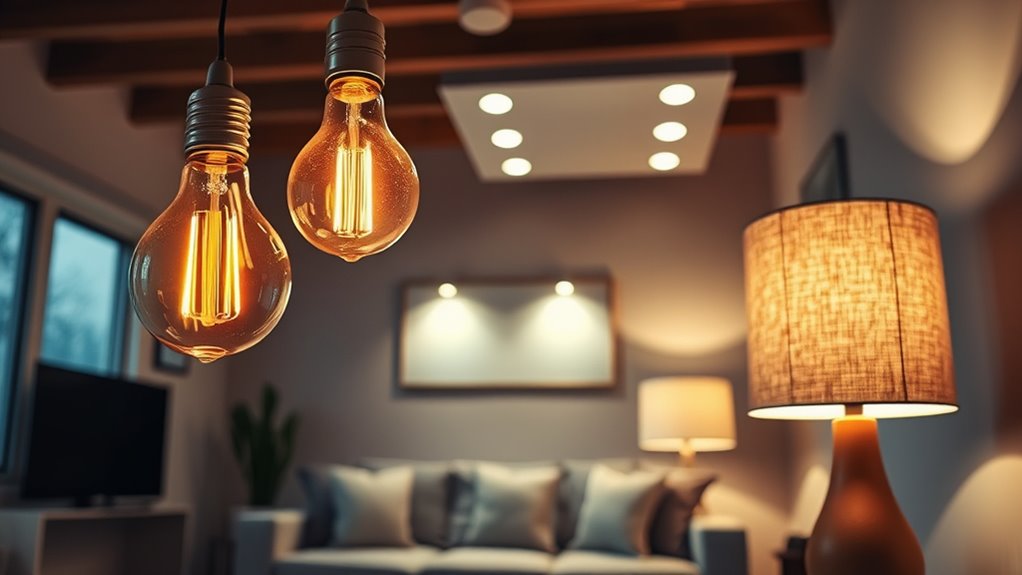
Selecting the right bulbs and fixtures is essential to achieve the desired ambiance and functionality in your space. Start by considering the purpose of each area—bright, focused lighting works well for kitchens and workspaces, while softer, warmer tones create a cozy atmosphere in living rooms and bedrooms. Opt for energy-efficient bulbs like LEDs, which last longer and use less power. Pay attention to color temperature; bulbs labeled “warm white” (around 2700K) produce a welcoming glow, whereas “daylight” (around 5000K) offers a crisp, invigorating light. Choose fixtures that complement your style and provide adequate light coverage. Wall sconces, pendant lights, and flush mounts can all serve different needs. Remember, the right combination of bulbs and fixtures sets the foundation for effective, beautiful lighting. Additionally, understanding lighting quality can help you select fixtures that enhance the overall look and feel of your space. For a farmhouse kitchen, incorporating vintage-inspired fixtures and warm light bulbs can add to the rustic charm and create a cozy environment. Incorporating energy-efficient solutions can also reduce your environmental impact and save on electricity costs.
Strategic Placement for Maximum Impact
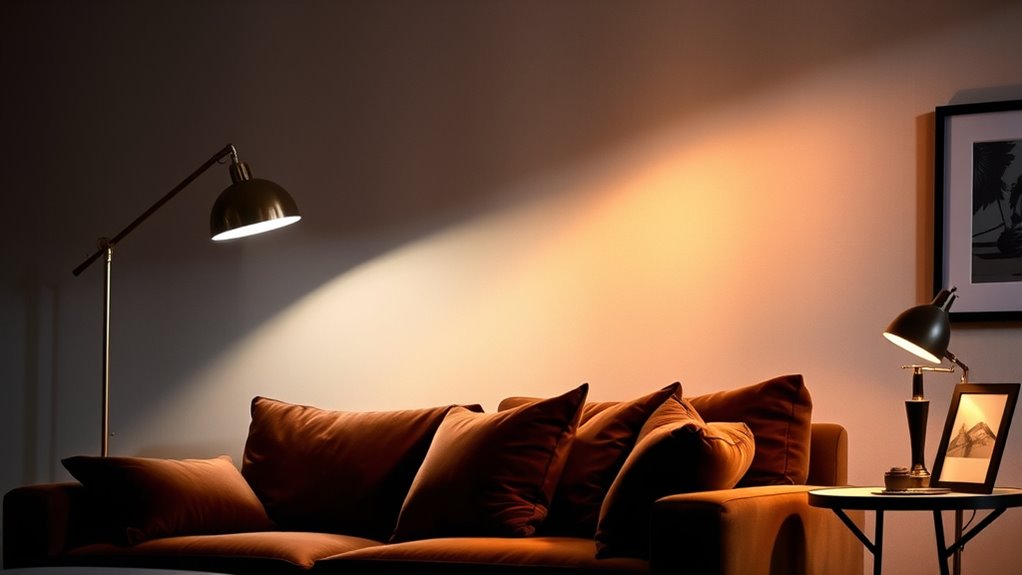
To achieve the greatest impact, placing your lights thoughtfully is key. Proper placement highlights your space’s best features and creates balance. Start by focusing light where it’s needed most—like task areas or focal points. Avoid placing fixtures in awkward spots that cast unwanted shadows or glare. Instead, consider these tips:
- Position lights at eye level or slightly above for natural, even illumination.
- Use layered lighting—combine ambient, task, and accent lights for depth.
- Aim fixtures to emphasize architectural details or artwork, avoiding direct glare.
Creating Mood and Atmosphere With Lighting

Creating the right mood and atmosphere with lighting involves more than just brightening a space; it requires intentional choices to evoke feelings and set the tone. You can use warm, soft lighting to create a cozy, inviting environment, perfect for relaxing or intimate gatherings. Conversely, bright, cool light energizes a space, making it ideal for work or lively social settings. Dimming lights allows you to easily shift from active to relaxed moods, adding flexibility. Accent lighting highlights artwork or architectural features, adding depth and focus, while layered lighting combines different sources to craft a balanced and dynamic ambiance. By thoughtfully selecting color temperatures, light intensities, and placement, you shape the emotional impact of each room, transforming a plain space into an expressive environment. Checking lighting hours can help ensure your lighting setup aligns with daily routines and activities. Incorporating lighting technology can further enhance control and customization of your lighting environment, especially considering how security zones are increasingly integrated with smart security and lighting systems for optimal safety and ambiance. Additionally, understanding residential and commercial applications can guide you in choosing the right lighting solutions for different spaces and needs. Properly managing privacy and cookie usage can also be crucial when designing digital lighting controls or smart home systems, ensuring user preferences are respected.
Energy Efficiency and Safety Considerations

Choosing between LED and incandescent bulbs affects both your energy bills and safety. Using the correct wattage guarantees your fixtures operate safely and efficiently. Don’t overlook emergency lighting, which is essential for safety during power outages. Additionally, soundscapes in ads can influence perceptions of safety and quality in lighting products. Incorporating digital literacy principles into your lighting choices can also enhance your understanding of energy-efficient options and safety features. Being aware of automotive water spot removers can help prevent damage caused by improper cleaning techniques that might compromise lighting fixtures or paint. Moreover, advancements in automation in business can inform smarter lighting system designs that optimize energy use and safety. Understanding brand trustworthiness can guide you in selecting reliable lighting products that meet safety standards and performance expectations.
LED vs. Incandescent
While both LED and incandescent bulbs serve the same basic purpose, they differ markedly in energy efficiency and safety. LEDs consume notably less electricity, which saves you money and reduces environmental impact. They also generate less heat, lowering the risk of burns or fires. Incandescents, on the other hand, are less efficient and produce more heat, making them less safe long-term. When choosing between them, consider these points:
- LEDs use up to 75% less energy than incandescent bulbs.
- LEDs emit minimal heat, reducing fire hazards.
- Incandescents have a shorter lifespan, leading to more frequent replacements.
- LED technology often incorporates smart features for added convenience and control.
Proper Wattage Use
Using the correct wattage for your light bulbs is essential for both energy efficiency and safety. Too high a wattage can cause bulbs to overheat, increasing the risk of fires or damage to fixtures. Always check your fixture’s maximum wattage rating—usually indicated on a label or in the manual—and never exceed it. Using bulbs with lower wattage than the fixture’s maximum is fine and saves energy, but don’t use a bulb with a wattage that surpasses the recommended limit. Additionally, opt for energy-efficient bulbs, like LEDs, which produce the same brightness at lower wattages. This not only reduces your electricity bill but also minimizes heat output, keeping your space safer while maintaining ideal lighting. Being aware of lighting safety guidelines can help prevent accidents and prolong the life of your fixtures. Understanding electrical safety standards is also crucial to avoid potential hazards and ensure your lighting setup remains secure. Proper wattage selection contributes to bicycle tire longevity in storage by reducing excess heat that could damage components over time.
Emergency Lighting Safety
Are you aware of the importance of proper emergency lighting safety to both protect occupants and conserve energy? Ensuring your emergency lighting systems are reliable minimizes risks during power outages and reduces energy waste. To optimize safety and efficiency, consider these key points:
- Regular Maintenance – Inspect emergency lights frequently to ensure they’re operational and charged.
- Energy-Efficient Options – Install LED emergency lights to lower energy consumption while maintaining brightness.
- Compliance Checks – Follow local safety codes and standards to guarantee your setup meets legal requirements.
- Educating staff and occupants about emergency procedures helps in creating a safer environment during outages and emergencies.
- Recognizing angel number signs related to love and relationships can help in understanding potential soulmate connections and timing.
- Incorporating energy-efficient lighting solutions can further enhance both safety and sustainability in your emergency preparedness plans and contribute to overall energy conservation goals. Additionally, choosing lighting with advanced control systems can optimize performance and reduce unnecessary energy use.
Tips for DIY Lighting Projects
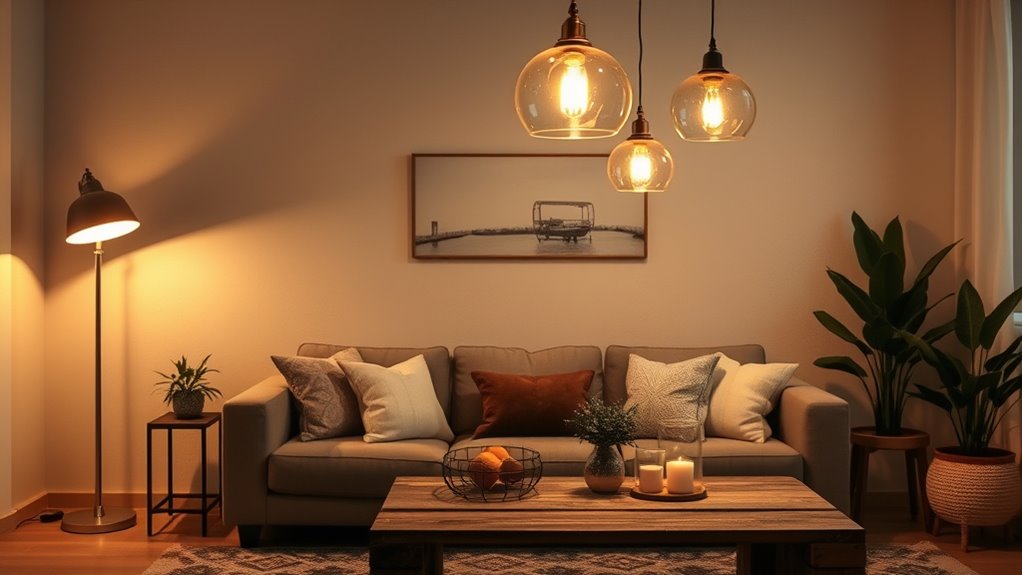
Starting a DIY lighting project can be rewarding, but it’s important to plan carefully before you begin. First, assess your space and decide what kind of lighting you need—ambient, task, or accent. Measure the area and create a detailed plan, including where to place switches and outlets. Choose the right fixtures and bulbs that match your style and provide adequate brightness. Always turn off power at the breaker before working on any electrical components. Use proper tools and follow safety guidelines to avoid accidents. If wiring seems complex, don’t hesitate to consult a professional. Keep your workspace organized, and test each fixture before completing the installation. Additionally, consider how indoor aesthetics can be enhanced with your lighting choices. With careful planning and attention to detail, your DIY lighting project will transform your space beautifully.
Frequently Asked Questions
How Can Smart Lighting Enhance My Space’S Ambiance?
Smart lighting can truly elevate your space’s ambiance by allowing you to customize brightness, color, and even schedules with ease. You can create cozy, relaxing atmospheres for unwinding or lively settings for entertaining, all at the tap of a button or through voice control. With smart lighting, you’re in command of your environment, making it simple to set the perfect mood for any occasion.
What Are the Latest Trends in Lighting Design?
You’re curious about current lighting trends, and you’ll love the latest look. Think sleek, statement-making chandeliers, smart systems simplifying setups, and sustainable solutions shining bright. You’ll notice bold bulbs, minimalistic designs, and color-changing options creating mesmerizing atmospheres. The trend is all about blending beauty with functionality, so you can create cozy, contemporary, and customizable spaces. Stay ahead by embracing innovative ideas that illuminate your style and elevate your environment effortlessly.
How Do I Troubleshoot Flickering or Inconsistent Lighting?
When your lights flicker or seem inconsistent, start by checking the bulbs and connections. Verify bulbs are screwed in tightly and replace any that are burnt out. Turn off the power before inspecting switches and wiring for loose or damaged parts. If the problem persists, consider the circuit load or faulty dimmers. If you’re unsure, it’s best to call an electrician to safely diagnose and fix the issue.
Can Lighting Improvements Increase My Home’S Resale Value?
Think of lighting upgrades as giving your home a fresh coat of paint—small changes can make a big difference. Improving your lighting can highlight your home’s best features and create a welcoming atmosphere, which buyers notice. According to real estate studies, well-lit homes sell faster and often fetch higher prices. So, yes, upgrading your lighting can boost your home’s resale value and make it more appealing to potential buyers.
What Are Eco-Friendly Options for Sustainable Lighting?
You want eco-friendly options for sustainable lighting, and there are great choices available. You can switch to LED bulbs, which use less energy and last longer. Consider solar-powered lights for outdoor spaces, reducing your reliance on electricity. You might also explore fixtures made from recycled or sustainable materials. By choosing these options, you help the environment while saving energy and money over time.
Conclusion
By thoughtfully blending different lighting styles, you gently shape the ambiance of your space, guiding the mood without overwhelming it. With careful placement and the right choices, you subtly invite warmth, comfort, and clarity into your home. Embrace the process, trusting your instincts as you fine-tune each element. In doing so, you craft an environment that feels just right—effortlessly transformed by your touch, shining softly with your personal style.
